Hasegawa 1/32 P-40N Warhawk
|
KIT #: |
08195 |
|
PRICE: |
4600 yen or less at
www.hlj.com
|
|
DECALS: |
One option |
|
REVIEWER: |
Tom Cleaver |
|
NOTES: |
Eduard photo etch cockpit details.
Zotz ZTZ32-030 “P-40N Warhawks” used |
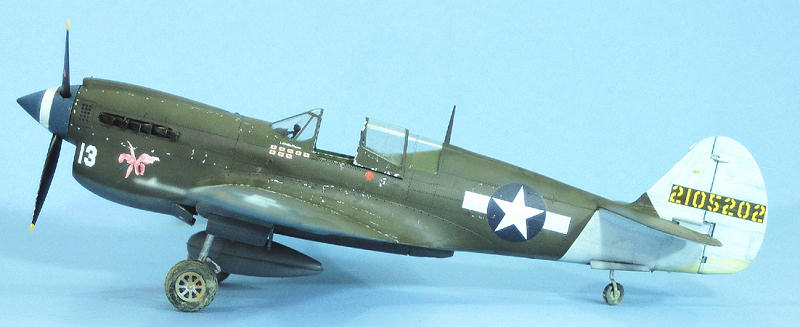
Throughout its career, the P-40 suffered from a high weight-to-power
ratio, and was several times the subject of “weight reduction” programs that
would manage to pare off perhaps as much as 100 pounds, but with little real
improvement in performance. The
P-40N, major production version of the P-40, began its life as a result of the
second major weight reduction program.
The early P-40N-1 was armed with only four .50 caliber machine guns.
Additionally, the front wing tank was removed, and aluminum oil coolers
and radiators were used, as well as using smaller, lighter wheels from the P-51,
for a total combat weight of 8,850 lbs, some 1,500 pounds less than the
preceding P-40M. Powered by the
Allison V-1710-81 engine, which reduced power to 1,200 h.p. but increased
altitude rating to 17,800 ft, the result was an increase in maximum speed to 378
m.p.h., fastest of the series.
After less than 200 P-40Ns had been produced, the two machine guns and the 137
gallon wing tank were restored,
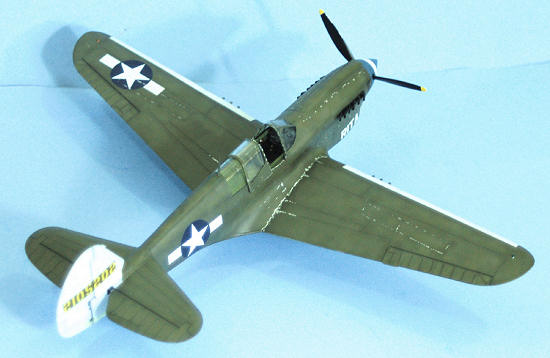 raising
the weight to 11,400 lbs. Beginning
with the P-40N-5, the original canopy was replaced by a frameless hood, with a
deeper rectangular aft section to improve view.
The most widely-built version was the P-40N-20, which saw a production
run of 3,022 aircraft. By the time
production of the P-40 ended in the summer of 1944, more than 14,000 of all
variants had been delivered and the airplane had seen active service on every
front and been flown by air forces on both sides.
raising
the weight to 11,400 lbs. Beginning
with the P-40N-5, the original canopy was replaced by a frameless hood, with a
deeper rectangular aft section to improve view.
The most widely-built version was the P-40N-20, which saw a production
run of 3,022 aircraft. By the time
production of the P-40 ended in the summer of 1944, more than 14,000 of all
variants had been delivered and the airplane had seen active service on every
front and been flown by air forces on both sides.
The 49th Fighter Group:
Curtis LeMay said the battle for air superiority over
Tokyo
was won in the skies of
New
Guinea.
Japanese pilots had a saying: "No one ever returns alive from
New
Guinea."
The Japanese Army Air Force pilots called
New
Guinea
“the graveyard of pilots,” which gives an indication of the long and hard-fought
air battles that occurred over the largest island in the Pacific from early 1942
until the Japanese were finally driven out in the summer of 1944. An indication
of what the Fifth Air Force achieved in this struggle came when
U.S.
Navy carrier planes raided the
Philippines
in August and September, 1944.
Opposition was so light that Rear Admiral Robert Carey - Chief of Staff to
Admiral William Halsey - wrote to MacArthur’s Chief of Staff, General Richard
Sutherland that General George Kenney’s pilots had “just about spoiled the war
for our carriers.”
One of the organizations most responsible for this was the 49th
Fighter Group, the first organized American fighter unit to enter the Pacific
War after the attack on
Pearl
Harbor.
By the fall of 1942, the Japanese threat to
Australia
had receded and the front line of the war in the southwest Pacific was
New Guinea.
The 49ers began operating on the big island that fall, with squadrons
rotating through
Port
Moresby
while at least one squadron maintained fighter defense for northern
Australia
at
Darwin.
The 9th Fighter Squadron was re-equipped with P-38s in early
1943, as General Kenney tried to have at least one squadron in each of his P-39
and P-40-equipped fighter groups equipped with what he considered the best
fighter available. The 7th
and 8th Squadrons, which continued to operate P-40s, transferred
full-time to
New
Guinea
in March 1943.
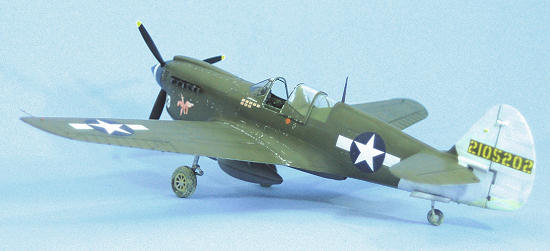 In fighting through the Western Pacific from 1942-45, The 49th
Fighter Group scored 668 confirmed air-to-air kills. 313 of these went to pilots
in P-40s, fighting over
New
Guinea.
In fighting through the Western Pacific from 1942-45, The 49th
Fighter Group scored 668 confirmed air-to-air kills. 313 of these went to pilots
in P-40s, fighting over
New
Guinea.
Robert DeHaven:
Many of the 49th FG pilots liked the P-40, even though its
performance was not up there with the P-38 and P-47 that equipped other units.
One such pilot was Lieutenant Robert DeHaven, who left
Washington
and
Lee
University
in February 1942 to join the Army Air Corps. Earning his wings that summer, he
was assigned to P-40 training in Florida and was sent to Hawaii in February
1943, then on to Port Moresby, New Guinea via Australia in May, where he flew
with the P-40-equipped 7th Fighter Squadron at Dobodura. DeHaven arrived in the
group at about the same time the P-40N replaced the unit’s tired P-40Es and
P-40Ks.
DeHaven scored his first victory on
July
14, 1943
and his fifth on December 10. He participated in the offensives that took Buna,
Lae, the
Markham
Valley,
Hollandia and
Biak
Island
by the summer of 1944. His score during this period of 10 enemy aircraft by
January 1944 was tied for the highest P-40 score by a USAAF pilot in the SWPA.
DeHaven was one who preferred the P-40 over the P-38. In “Fire in the
Sky: The Air War in the South Pacific,” DeHaven explains:
“After training I requested duty in the Pacific and I requested being
posted to a P-40 squadron and both wishes were granted. This was early in 1943
and most pilots already desired more advanced types and some thought my decision
a mistake. Yet I had been inspired by the deeds of the Flying Tigers. We had
also heard accounts that the P-38 was difficult to bail out of because of its
twin-boom tail and that it was difficult when flying with one engine. I also
knew that P-38s were still rare in the theater and I wanted to get into the war
as soon as possible. That wish, too, was granted. I never regretted the choice.
“If you flew wisely, the P-40 was a very capable aircraft. In many
conditions, it could out turn a P-38, a fact that some pilots didn’t realize
when they made the transition between the two aircraft. The P-40 kept me alive
and allowed me to accomplish my mission. The real problem with it was lack of
range. As we pushed the Japanese back, P-40 pilots were slowly left out of the
war. So when I moved to P-38s, an excellent aircraft, I did so not because I
believed that the P-40 was an inferior fighter, but because I knew the P-38
would allow us to reach the enemy. I was a fighter pilot and that was what I was
supposed to do.”
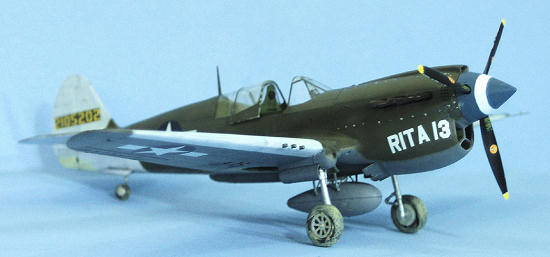 As both my old friend the late Erik Shilling and AVG ace Charles Older
discovered, DeHaven learned to keep his speed up in combat, since above 250 mph
the P-40 could out-turn the Ki.43 with its larger ailerons which was its main
opponent.
As both my old friend the late Erik Shilling and AVG ace Charles Older
discovered, DeHaven learned to keep his speed up in combat, since above 250 mph
the P-40 could out-turn the Ki.43 with its larger ailerons which was its main
opponent.
Following the invasion of
Biak,
the 7th Fighter Squadron transitioned to P-38s in August-September 1944 for the
Philippine invasion, and the 49ers finally became an all-P-38 outfit. DeHaven
would score four more victories in the
Philippines
before rotating home in February 1945.
After the war, DeHaven returned home to Hollywood where he was raised -
he was a member of the DeHaven family that included his uncle, actor Carter
DeHaven Sr.; cousins Carter DeHaven Jr., an Assistant Director;
Carter DeHaven
III,
who produced the excellent sports movie “Hoosiers”;
and special effects supervisor Carter DeHaven IV; as well as his other
cousin, actress Gloria DeHaven. He
was spotted in the fall of 1945 by an agent and hired as an actor by
Columbia
Pictures. After playing small roles
in three movies in 1945-46, he met Howard Hughes and became his personal pilot
in 1947. In 1949, DeHaven became
Hughes’ chief test pilot, and by the mid-1950s he was Director of Flight Test,
running the Aviation Test Section for Hughes Aircraft all on his own “as if he
was Howard,” in the words of one who worked with him, a position he held until
his retirement in 1987. During his
time at Hughes, DeHaven was responsible for the development of the Hughes OH-6
helicopter series, and for getting the company involved in the development of
air-to-air guided missiles.
In 1946, Robert DeHaven married big band singer Connie Haines, with whom
he had two children before divorcing in 1960.
He remarried in 1967, and died in
Encino,
California,
in 2008. He was one of the founders
of the American Fighter Aces Association in 1960, and was President of the group
during the 1970s. In 1987, when
Carter DeHaven
III
was trying to buy my screenplay “The Magic Bus,” he invited me to lunch with his
cousin, knowing my interest in World War II aviation.
As with many World War II fighter aces I have met over the years, a few
knowledgeable questions (and a couple martinis) resulted in a “colorful”
conversation, the result of which was that I became very interested in learning
more about the 49ers, a unit I wasn’t that familiar with at the time.
As to what’s in the box, read Scott’s
preview from last
week.
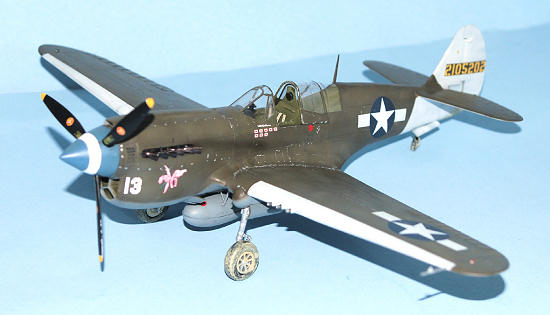 The P-40N has been previously done in 1/48 by
AMT
and Mauve, with the Mauve kit being the better of the two in terms of surface
detail and look when completed, before being done by Hasegawa in what has to be
considered the definitive version.
The P-40N has been previously done in 1/48 by
AMT
and Mauve, with the Mauve kit being the better of the two in terms of surface
detail and look when completed, before being done by Hasegawa in what has to be
considered the definitive version.
This new kit is the first P-40N in 1/32 scale, and is effectively a
scale-up of the 1/48 kit, as are all the P-40s in this series of 1/32 kits.
Like the P-40K, it is a “Special Edition” kit - meaning it is a limited
release and you should get yours soon if you want it.
The kit comes with both the “large” and “small” wheels, which is nice.
P-40Ns operating in
China
and the
CBI
typically maintained the use of the “standard” P-40 wheel due to supply problems
of the new wheels.
While Scott expressed a liking for the kit decals of the “15,000th
Curtiss Fighter Special,” I wanted an operational airplane.
Fortunately, Zotz Decals has come through with a sheet that has three 7th
FS, 49th FG, P-40Ns: DeHaven’s “Rita 13"; “Daddy Please/Milk Wagon
Express;” the natural metal finish P-40N flown by 7th FS CO Major
Gerald Johnson; and “White 21,” flown by Captain Harlyn Vidovich of the 74th
FS, 23rd FG in China in 1944.
There is really not much else to say about assembling the Hasegawa P-40s
in either 1/48 or 1/32 scale, beyond what I have said in my other reviews.
The secret to the assembly, since the kit has so many “plug in” parts, is
careful fitting of those parts, so that you get a good fit and the seams that
are created can be filled to get a smooth final surface.
I assemble the tail to the forward fuselage in
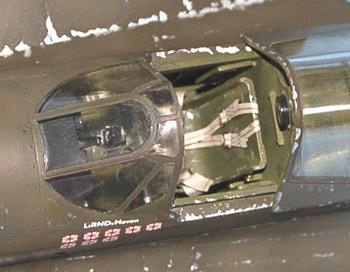 halves,
before gluing the fuselage halves together, so I can work the fit of the parts
from both inside and outside, to get a smooth fit, which I sand with a sanding
stick before and after covering the seam with Tamiya’s Mr. Surfacer substitute.
It’s also important to get the fit of the gun plugs in the wings to
obtain a smooth surface in that area. Once these items are attended to, the rest
of the assembly is easy.
halves,
before gluing the fuselage halves together, so I can work the fit of the parts
from both inside and outside, to get a smooth fit, which I sand with a sanding
stick before and after covering the seam with Tamiya’s Mr. Surfacer substitute.
It’s also important to get the fit of the gun plugs in the wings to
obtain a smooth surface in that area. Once these items are attended to, the rest
of the assembly is easy.
I used the kit cockpit, which had a nice result, with Eduard photoetch
seat belts for the final touch.
One thing to note is that the P-40N had a very different canopy than
other P-40s, with the cut down decking and a full plexiglass rear canopy to
improve rear vision. Almost
everyone over the years has painted the “frames” on this canopy, and everyone
who has done so (including yours truly), has been wrong!
The rear canopy was assembled from plexiglass sections, and those
sections were reinforced with plexiglass strips that were glued in position on
the outside, with the result that the strip area “fogged.”
This is what was seen by the “hexperts” over the years as painted
“framing.” It is much like the
Emerson and Martin gun turrets on B-24s, B-25s and B-26s, all of which were
produced “unpainted” with strips glued on that appear in black and white photos
to be “framing.” With this kit, you
could use a 0000 brush and paint on some glue to “fog” the strips, or you could
leave them alone, which is what I did.
Painting:
I first applied pre-shading to the model, airbrushing flat black over all
the panel lines, before proceeding.
I used thinned Tamiya “Flat White” for the tail and wing leading edge, so
it would give a “ragged” appearance over the black.
While regulations called for the entire tail to be painted white, the 49th
FG kept the upper surfaces of the horizontal
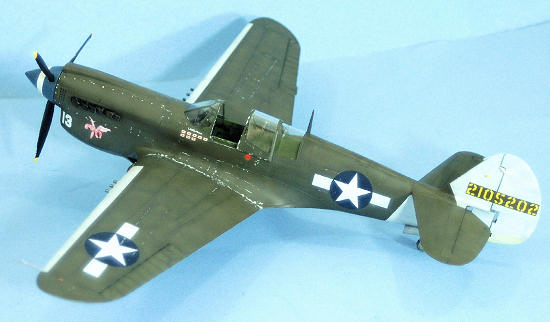 stabilizer
in Olive Drab for camouflage purposes since the airplanes were based on forward
airfields and subject to attack while on the ground by Japanese aircraft, for
which an all-white tail was a good way of spotting the target.
The “early” P-40Ns acquired by the group (identifiable in photos by
having white bars painted to either side of the star cockades without the red
surround) more than likely had the upper surfaces left in olive drab, since
every photo of one of these airplanes where one can make a determine about this
are so painted. Once these areas were dry, I masked with Tamiya tape.
stabilizer
in Olive Drab for camouflage purposes since the airplanes were based on forward
airfields and subject to attack while on the ground by Japanese aircraft, for
which an all-white tail was a good way of spotting the target.
The “early” P-40Ns acquired by the group (identifiable in photos by
having white bars painted to either side of the star cockades without the red
surround) more than likely had the upper surfaces left in olive drab, since
every photo of one of these airplanes where one can make a determine about this
are so painted. Once these areas were dry, I masked with Tamiya tape.
The lower surfaces were painted with Tamiya “Neutral Grey” while the
upper surfaces were painted with a mixture of Tamiya “Khaki Drab” and “Olive
Drab” to get the more “brown” Olive Drab that came into general use in 1943.
I then added more Khaki Drab and increased additions of Flat White as I
went over the upper surfaces to create the effect of “sun fading,” of which I
did quite a bit since this airplane had been in New Guinea for six months.
The spinner was painted with Xtracrylix British Blue, since the 49th FG
used available paints in Australia for their squadron colors.
Decals:
After applying Xtracrylix Gloss Varnish, I applied the decals.
The decal instructions would have you use the later “blue surround”
national insignia, but the photos I found of DeHaven’s airplane definitely
confirm it had the earlier style of marking, which the sheet also provides.
The instructions say that this is the airplane as it appeared in August
1943, but the scoreboard confirms that this is “Rita 13" as she appeared in
January 1944. I particularly liked
the provision of the white stripe for the spinner, which obviated the need to do
a lot of masking that likely wouldn’t have ended up looking nearly so right.
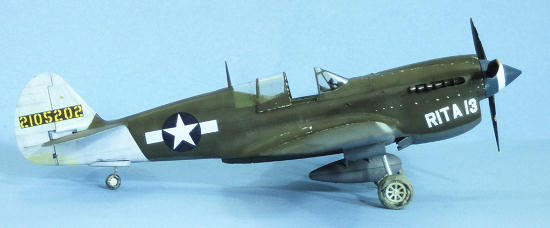 I gave the model an overall coat of Xtracrylix Satin Varnish, then
weathered it with Tamiya “smoke” to get exhaust and oil stains and Tamiya “Flat
Aluminum” for “dings” to the paint.
I then applied two coats of Xtracrylix Flat Varnish, with a dollop of Tamiya
“Flat Base” to get the tropical sun-faded flat finish I was going for. I also
“muddied” the tires, wheel wells and lower wing behind the wheel wells, and the
tail, using the Tamiya Weathering Set.
I gave the model an overall coat of Xtracrylix Satin Varnish, then
weathered it with Tamiya “smoke” to get exhaust and oil stains and Tamiya “Flat
Aluminum” for “dings” to the paint.
I then applied two coats of Xtracrylix Flat Varnish, with a dollop of Tamiya
“Flat Base” to get the tropical sun-faded flat finish I was going for. I also
“muddied” the tires, wheel wells and lower wing behind the wheel wells, and the
tail, using the Tamiya Weathering Set.
I attached the landing gear and doors and the prop, and unmasked the
canopy. The sliding portion can be positioned open, but I would personally use a
vac canopy for a future model, if one were available, since the thinner canopy
will look more accurate.
Out of the box, with no additional add-ons other than aftermarket decals
and seat belts, the 1/32 Hasegawa P-40N looks great and continues the tradition
founded by the P-40E of being an accurate P-40.
Given the many different air forces the P-40N flew with, one hopes there
will be other aftermarket sets. I
do know that Ventura Decals is releasing a sheet of RNZAF Kittyhawk IVs and that
Red Roo plans to do a sheet of Kittyhawk IVs of 80 Wing RAAF.
The kit is highly recommended.
Thanks to HobbyLink Japan for the
review kit. Get yours at
www.hlj.com. Decals courtesy of
Zotz Decals. Get them at
www.zotzdecals.com
Tom Cleaver
September 2009
If you would like your product reviewed fairly and quickly, please
contact
me or see other details in the
Note to
Contributors.
Back to the Main Page
Back to the Review
Index Page


 raising
the weight to 11,400 lbs. Beginning
with the P-40N-5, the original canopy was replaced by a frameless hood, with a
deeper rectangular aft section to improve view.
The most widely-built version was the P-40N-20, which saw a production
run of 3,022 aircraft. By the time
production of the P-40 ended in the summer of 1944, more than 14,000 of all
variants had been delivered and the airplane had seen active service on every
front and been flown by air forces on both sides.
raising
the weight to 11,400 lbs. Beginning
with the P-40N-5, the original canopy was replaced by a frameless hood, with a
deeper rectangular aft section to improve view.
The most widely-built version was the P-40N-20, which saw a production
run of 3,022 aircraft. By the time
production of the P-40 ended in the summer of 1944, more than 14,000 of all
variants had been delivered and the airplane had seen active service on every
front and been flown by air forces on both sides. In fighting through the Western Pacific from 1942-45, The 49th
Fighter Group scored 668 confirmed air-to-air kills. 313 of these went to pilots
in P-40s, fighting over
In fighting through the Western Pacific from 1942-45, The 49th
Fighter Group scored 668 confirmed air-to-air kills. 313 of these went to pilots
in P-40s, fighting over 

 halves,
before gluing the fuselage halves together, so I can work the fit of the parts
from both inside and outside, to get a smooth fit, which I sand with a sanding
stick before and after covering the seam with Tamiya’s Mr. Surfacer substitute.
It’s also important to get the fit of the gun plugs in the wings to
obtain a smooth surface in that area. Once these items are attended to, the rest
of the assembly is easy.
halves,
before gluing the fuselage halves together, so I can work the fit of the parts
from both inside and outside, to get a smooth fit, which I sand with a sanding
stick before and after covering the seam with Tamiya’s Mr. Surfacer substitute.
It’s also important to get the fit of the gun plugs in the wings to
obtain a smooth surface in that area. Once these items are attended to, the rest
of the assembly is easy. stabilizer
in Olive Drab for camouflage purposes since the airplanes were based on forward
airfields and subject to attack while on the ground by Japanese aircraft, for
which an all-white tail was a good way of spotting the target.
The “early” P-40Ns acquired by the group (identifiable in photos by
having white bars painted to either side of the star cockades without the red
surround) more than likely had the upper surfaces left in olive drab, since
every photo of one of these airplanes where one can make a determine about this
are so painted. Once these areas were dry, I masked with Tamiya tape.
stabilizer
in Olive Drab for camouflage purposes since the airplanes were based on forward
airfields and subject to attack while on the ground by Japanese aircraft, for
which an all-white tail was a good way of spotting the target.
The “early” P-40Ns acquired by the group (identifiable in photos by
having white bars painted to either side of the star cockades without the red
surround) more than likely had the upper surfaces left in olive drab, since
every photo of one of these airplanes where one can make a determine about this
are so painted. Once these areas were dry, I masked with Tamiya tape. 